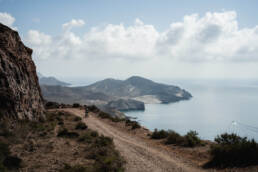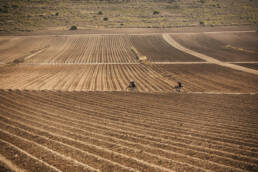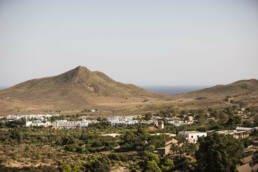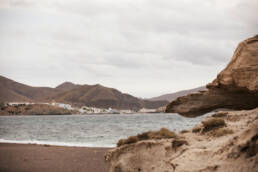Located on the southeastern coast of Almería, the Cabo de Gata-Níjar Natural Park boasts a rugged landscape of volcanic rock formations, with sharp peaks and crags that create beautiful coves along fifty kilometers of the most well-preserved coastline on the European Mediterranean.
Fauna and flora
The park is a unique botanical site, home to over a thousand exclusive species of flora. The arid plains are covered with dense formations of esparto grass, thyme, rosemary, and the most recognizable plant in the park – the agave americana, or pita plant, native to America. The Natural Park also provides habitat for around 1.100 species of fauna, most of which are steppe birds like stone curlews and crested larks, living alongside birds of prey and the snub-nosed viper.




5 MINUTES WITH SALVADOR PARRA,
DIRECTOR OF THE CABO DE GATA-NÍJAR NATURAL PARK
Why is this Natural Park so special?
It is a very special place because the richness it possesses from the point of view of biodiversity, geodiversity, cultural heritage, and landscape make the Cabo de Gata-Níjar Natural Park a unique ecosystem in Europe. Regarding the flora, more than 1000 terrestrial and 250 marine species have been cataloged, including several endemic species and an emblematic species such as Posidonia oceanica, a true bioindicator of the health of the marine ecosystem.
Regarding the fauna, around 150 species of birds (both resident and migratory), 22 species of reptiles and amphibians, 10 species of mammals, and an impressive diversity of invertebrates, with more than 1600 identified species, have been cataloged.
And regarding geodiversity, there are up to 33 geosites located within the natural space, with spectacular places such as the Mónsul climbing dune, the Los Escullos fossil dune, or the columnar jointing of Punta Baja. It is one of the most important volcanic areas of the Iberian Peninsula. All this richness has earned it up to three UNESCO international recognitions, such as World Geopark, Biosphere Reserve, and Special Protection Area of Importance for the Mediterranean (ZEPIM). Added to this is having a wetland of international importance within the RAMSAR Convention, such as Las Salinas de Cabo de Gata. It is difficult to find a natural space, already special by being maritime-terrestrial, that brings together so many figures of protection and recognition, both national and international.
What corner of the Cabo de Gata-Níjar can’t we miss?
It’s difficult to choose just one in particular, because the Cabo de Gata-Níjar Natural Park has many places of enormous beauty, both on the land and in the marine and underwater areas.
To name just a few, personally I wouldn’t miss the coves of Genoveses and Mónsul, the views from the Las Sirenas Reef or the Amatista Viewpoint, the Rodalquilar Valley, or taking some of the trails like Loma Pelada or Requena.
What positive impact do you think cycling can have on the territory?
Cycle tourism is an activity with many possibilities within the Natural Park, especially if we consider that it is a very sustainable activity and particularly suitable for development in periods outside the summer season, when temperatures are much milder.
From the point of view of environmental management, it is an activity compatible with conservation and the socioeconomic development it can generate (accommodations, restaurants, cycle tourism service companies, etc.), precisely the two main objectives that we pursue in said management. It is a very good tool in the search for the deseasonalization of tourism.
On the other hand, what recommendations could we give to cyclists so that this impact does not conflict with the conservation of the territory itself?
The recommendations for good practices are quite simple. Ride on the public trails that are compatible with cycling (visit and consult the information on the Visitor’s Window of the Department of Sustainability and Environment) and never go cross-country, collect any type of waste generated during the activity and deposit it in the containers available in urban areas, and do not take plants, stones, or rocks, nor disturb the animals.
With these simple rules, we will significantly contribute to the conservation of a unique natural space such as the Cabo de Gata-Níjar Natural Park.
RECOMMENDED TOUR
REMEMBER THIS IS A PROTECTED AREA, PLEASE HAVE A LOOK TO OUR ENVIRONMENTAL RECOMMENDATIONS
Sources: Andalucia.org / Juntadeandalucia.es / wikipedia.org